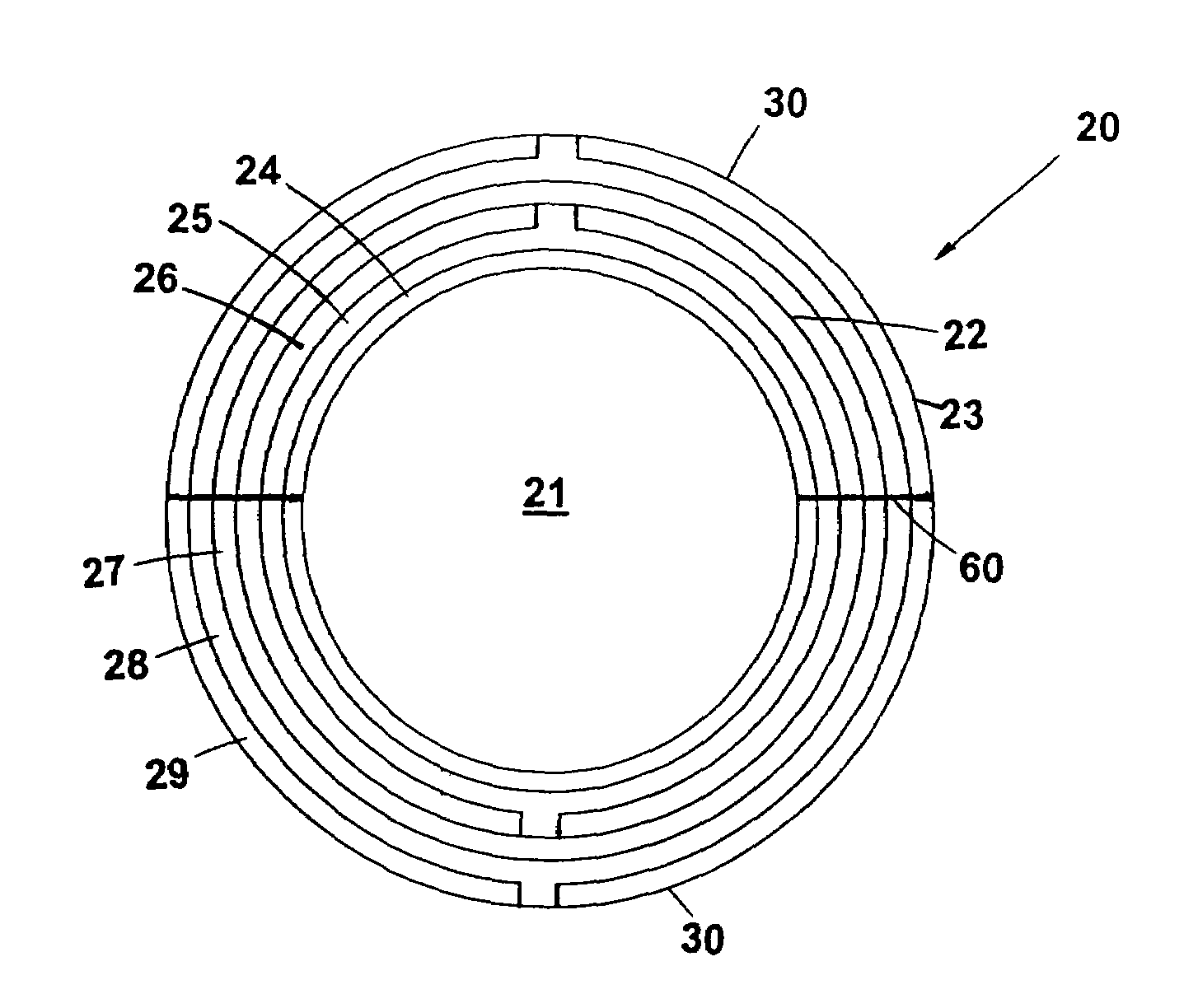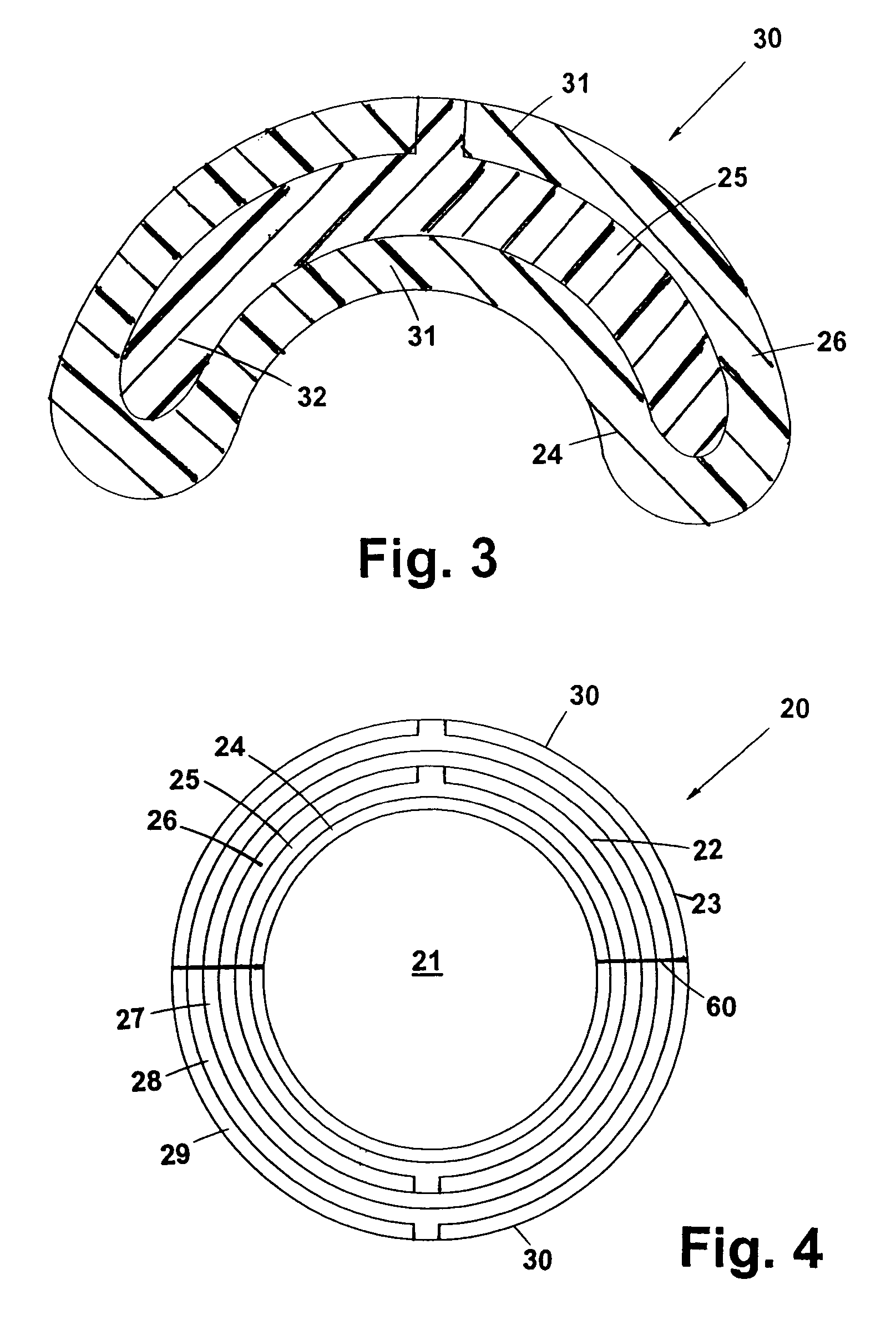Method for making golf ball with co-injected inner cover
a golf ball and inner cover technology, applied in the field of golf balls, can solve the problems of reducing the spin imparted and producing a less desirable “feel”
- Summary
- Abstract
- Description
- Claims
- Application Information
AI Technical Summary
Benefits of technology
Problems solved by technology
Method used
Image
Examples
example 1
[0049]A polybutadiene core 21 having a diameter of about 1.50 to 1.55 inches can be covered with a three-layer cover comprised of the following:
[0050]
FIRSTSECONDMATERIAL 11MATERIAL 21MaterialSURLYN 7930SURLYN 8320Composition30%70%Tensile Strength, psi3,8003,100Tensile Strain @ Break, %290770Flexural Modulus, psi67,0002,800Melt Flow, g / 10 min1.80.9Hardness, Shore D6825Bashore Resilienc5342*Material properties from supplier's data.
[0051]This example can be formed by forming cover hemispheres in a mold. The first and second materials should be heated to approximately 400–425° F. and injected into a 40° F. mold. The first material will adher to the surfaces of the mold to form the inner and outer layers of the cover hemisphere and the second material will flow between the inner and outer layers to form an intermediate layer. The two hemispheres can be compression molded about the polybutadiene core to form the inner cover of the ball. The inner cover is preferably formed to an outer dia...
example 2
[0055]A polybutadiene core having a diameter of about 1.50 to 1.55 inches is covered with an inner cover, which is covered by a three-layer outer cover comprised of the following:
[0056]
FIRSTSECONDMATERIAL 11MATERIAL 21MaterialSURLYN 8320SURLYN 7930Composition30%70%Tensile Strength, psi3,1003,800Tensile Strain @ Break, %770290Flexural Modulus; psi2,80067,000Melt Flow, g / 100.91.8Hardness, Shore D2568Bashore Resilience4253*Material properties from supplier's data.
[0057]A golf ball core can be covered with an inner cover such as those described in U.S. Pat. No. 5,688,191, which is incorporated herein in its entirety. Preferably, an inner cover comprising a dynamically vullcanized thermoplastic elastomer, functionalized styrene-butadiene elastomer, metallocene polymer or blends thereof is formed over the core such that the inner cover has an outer diameter of about 1.55 to 1.62 inches.
[0058]This example was formed by first forming cover hemispheres in a mold. The first and second materia...
example 3
[0059]A polybutadiene core having a diameter of 1.560 inches can be covered with a thin three layer inner cover of the material composition listed in Example 1 above, and a three layer outer cover of the material composition listed in Example 2 above.
[0060]This example was formed by first forming the inner cover hemispheres as described in Example 1 and compression molding them about the polybutadiene core, and then forming the outer cover hemispheres as described in Example 2 and molding them about the inner cover to form a golf ball having a total of 7 layers.
PUM
| Property | Measurement | Unit |
|---|---|---|
| temperature | aaaaa | aaaaa |
| temperature | aaaaa | aaaaa |
| temperature | aaaaa | aaaaa |
Abstract
Description
Claims
Application Information
 Login to View More
Login to View More - R&D
- Intellectual Property
- Life Sciences
- Materials
- Tech Scout
- Unparalleled Data Quality
- Higher Quality Content
- 60% Fewer Hallucinations
Browse by: Latest US Patents, China's latest patents, Technical Efficacy Thesaurus, Application Domain, Technology Topic, Popular Technical Reports.
© 2025 PatSnap. All rights reserved.Legal|Privacy policy|Modern Slavery Act Transparency Statement|Sitemap|About US| Contact US: help@patsnap.com



